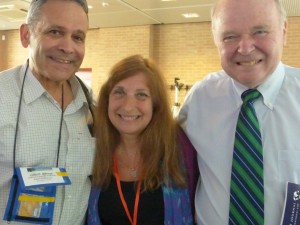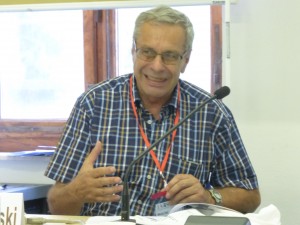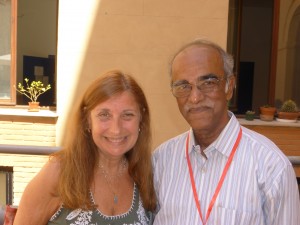Summer 2013
Summer 2013
I just returned from a fantastic international conference titled ‘The Aftermath of Genocide’ in Siena, Italy sponsored by the International Association of Genocide Scholars. There I met with experts, world-wide, who have made enormous contributions to our understanding of Genocide, its causes, its details and its prevention.
Among the most notable for me were:
Greg Stanton, whose pivotal Eight Stages of Genocide were referenced again and again throughout the conference because he was the first to see patterns and categorize them in a way that made the path to Genocide clearly comprehensible–and when we understand something, we can see it, we can identify it and most importantly, we can try to stop it. Unlike what you might think, the eighth stage is not Extermination–that is the seventh. Instead, the final step in Genocide is Denial.
Although it is incredibly worthwhile to read Stanton’s articles in their entirety, until that is possible, here, in brief, are the Eight Stages of Genocide, thanks to Greg Stanton of George Mason University’s Dep’t of Peace and Conflict Resolution:
- Classification
- Symbolization
- Dehumanization
- Organization
- Polarization
- Preparation
- Extermination
- Denial
Elihu Richter is a public health physician, an epidemiologist based in Jerusalem, who has taken the medical model for treating epidemics and applied it to Genocide. As he explained many years ago when we met in Sarajevo at a conference at which we both spoke (held on 10th anniversary of Sbrenica massacre): There are ways that we, as doctors, have learned to prevent epidemics and contain the spread of diseases. Similar techniques can be adapted to identify the ‘pathogens’ of hatred and stop their spread so that they, too, do not become an epidemic of murder and genocide. Elihu’s writing on the subject adds more worthwhile Genocide material to read.

Elihu Richter, Ann and Greg Stanton in Siena, Italy
Maciej Kozlowski, former Polish Ambassador to the United States, discussed his research on reknowned Polish courier, Jan Karski, who was famously smuggled into the Warsaw Ghetto by Jewish leaders so that Karski could see, with his own eyes, exactly how devastating conditions aqctually were in the ghetto.
When Jan Karski encountered the ghetto’s starvation, bloated dead bodies in the streets, the rampant disease and dire suffering everywhere, he found it unbearable–and could only endure being in the Ghetto a very short time. However, it was enough time for Karski to be able to verify the horror. The Jewish Ghetto leaders gave Karski a list of important actions that the Allies could do — including bombing the railroad tracks leading to Auschwitz — which, when done, would help stop, or at least reduce, Nazi’s efficient mass murder machine of the Jews. Karksi did, in fact, share this critical information with Allied leaders. And it is his (in)famous 1943 meeting with FDR that is most telling– and most damning.

Maciej Kozlowski
Here is what happened: After Karski described the horrors he had witnessed, and enumerated crucial actions Roosevelt needed take in order to save millions of Jews still alive, Roosevelt’s ONLY response was, “We will win the war.”
In other words, Roosevelt would take no direct action. At this point in the war, more than 3 million of the 6 million Jews who would eventually die, were still alive. Despite FDR’s greatness as a President in domestic issues, and I agree that he was a good President for America, nevertheless, Roosevelt’s inaction after Karski’s visit stains him forever in my eyes, and in the opinion of many other scholars as well, with the blood of the 3 million, many of whom could still have been saved in 1943, if only Roosevelt had undertaken the actions on the list given to Karski by the Warsaw Ghetto leaders.
As additional insight, it is worthwhile to describe Jan Karski’s meeting with legendary Supreme Court jurist, Justice Louis Brandeis. After Karski delineated the horrors of the Jewish situation in Nazi Europe, and Justice Brandeis was incredulous, someone asked Brandeis, “Are you saying that this Polish officer is lying?” Louis Brandeis’ response was very powerful: “No, I’m not saying that he’s lying. I’m just saying that I can’t believe it!”
By the way, until Maciej Kozlowski’s interviews with Karksi interviews, no one in Poland to knew anything about Jan Karski’s war-time missions nor his role as Polish underground courier. Karski, himself, never spoke about it after the war, and it was only after meeting Maciej that his incredible story finally became known in Karski’s native Poland!
Finally, though there are many other incredible people that I met at this Genocide conference, I’d like to introduce one more person to you before closing: Mofidul Hoque.
Mofidul Hoque is a soft-spoken scholar from Bangladesh who taught many other conference participants about the nature of the Genocide in Bangladesh, principally because he knows so much and because so little is known about it outside his country.
In addition to teaching this difficult history to students and adults in Bangladesh, Mofidul has also succeeded in organizing and building a museum, the Bangladesh Liberation War Museum, where this history can further be taught–using artifacts and narratives of the Genocide. And he expressed the hope that, when the museum’s temporary exhibit area is built, that The Last Album exhibition can even come to Bangladesh, together with its curator!

Ann with Mofidul Hoque
Ann
Posted in From Ann | No Comments »